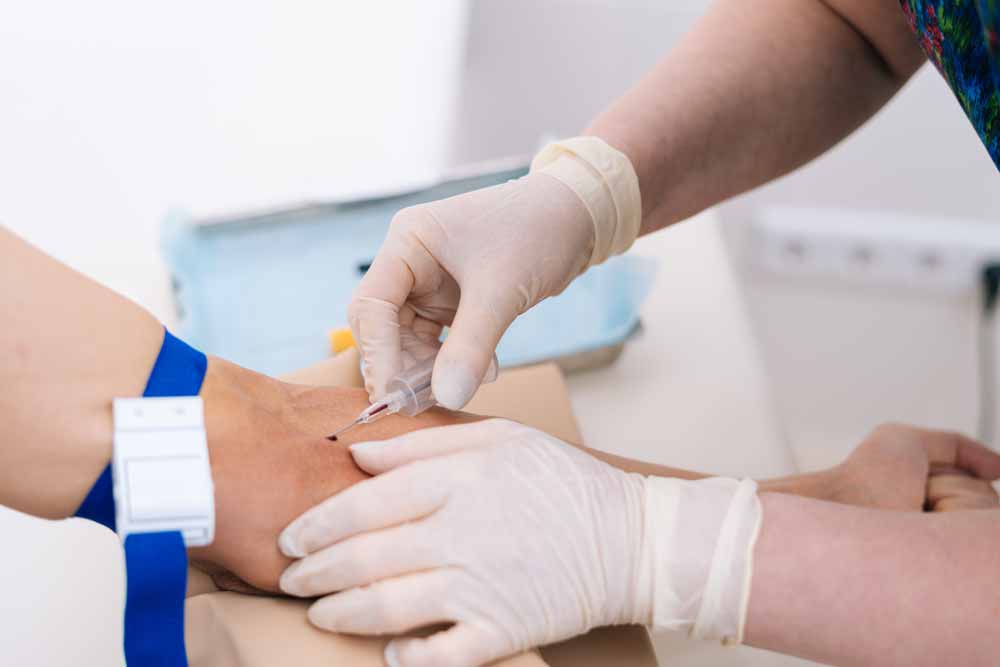Risk Factors for Venous Thromboembolism in Surgical Patients Caprini online calculator

Risk Assessment Scale in Surgical Patients – Risk Factors for Venous Thromboembolism Caprini / recommendations of the American College of Chest Physicians (АССР, 2012) on the prevention of VTE (J. Chest, 2012).
< 40 years
41-60 years
60-74 years
>=75 years
Without surgery
Minor elective surgery
Major surgery (over 45 min.), laparoscopic over 45 min. or arthroscopic
Elective major lower extremity arthroplasty
History of major surgery
Congestive heart failure
Sepsis
Pneumonia
Immobilization for medical reasons(plaster cast)
Hip, pelvis, or leg fracture
Stroke
Multiple trauma
Acute spinal cord injury causing paralysis
Varicose veins
Current swollen legs
Current central venous access
History of DVT/PE
Family history of thrombosis
Positive Factor V Leiden
Positive prothrombin 20210A
Elevated serum homocysteine
Positive lupus anticoagulant
Elevated anticardiolipin antibody
Heparin-induced thrombocytopenia
Other congenital or acquired thrombophilia
Normal, out of bed
Medical patient currently on bed rest
Patient confined to bed >72 hours
History of inflammatory bowel disease
Obesity (BMI >25)
Acute myocardial infarction
Chronic obstructive pulmonary disease
Present or previous malignancy
Other risk factors other risk factors, on oral contraceptives or hormone replacement (if female), history of unexplained stillborn, ≥3 spontaneous abortions, or premature birth with toxemia or growth-restricted infant (if female)
| Caprini Score: | Risk category | Risk percent | Recommended prophylaxis | Duration of chemoprophylaxis |
|---|---|---|---|---|
| 0 | 0 | 0 | 0 | 0 |
Details:
| Risk factor | Value | Score |
| Age (years) | < 40 | 0 |
| 41-60 | 1 | |
| 61-74 | 2 | |
| ≥75 | 3 | |
| Type of surgery | ||
| Without surgery | 0 | |
| Minor elective surgery | 1 | |
| Major surgery (over 45 min.), laparoscopic over 45 min. or arthroscopic | 2 | |
| Elective major lower extremity arthroplasty | 5 | |
| Recent (<1 month) events | ||
| History of major surgery | 1 | |
| Congestive heart failure | 1 | |
| Sepsis | 1 | |
| Pneumonia | 1 | |
| Immobilization for medical reasons (plaster cast) | 2 | |
| Hip, pelvis, or leg fracture | 5 | |
| Stroke | 5 | |
| Multiple trauma | 5 | |
| Acute spinal cord injury causing paralysis | 5 | |
| Venous disease or clotting disorder | ||
| Varicose veins | 1 | |
| Current swollen legs | 1 | |
| Current central venous access | 2 | |
| History of DVT/PE | 3 | |
| Family history of thrombosis | 3 | |
| Positive Factor V Leiden | 3 | |
| Positive prothrombin 20210A | 3 | |
| Elevated serum homocysteine | 3 | |
| Positive lupus anticoagulant | 3 | |
| Elevated anticardiolipin antibody | 3 | |
| Heparin-induced thrombocytopenia | 3 | |
| Other congenital or acquired thrombophilia | 3 | |
| Mobility | ||
| Normal, out of bed | 0 | |
| Medical patient currently on bed rest | 1 | |
| Patient confined to bed >72 hours | 2 | |
| Other present and past history | ||
| History of inflammatory bowel disease | 1 | |
| Obesity (BMI >25) | 1 | |
| Acute myocardial infarction | 1 | |
| Chronic obstructive pulmonary disease | 1 | |
| Present or previous malignancy | 2 | |
| Other risk factors other risk factors, on oral contraceptives or hormone replacement (if female), history of unexplained stillborn, ≥3 spontaneous abortions, or premature birth with toxemia or growth-restricted infant (if female) | 1 |
Results:
| Caprini Score | Risk category | Risk percent* | Recommended prophylaxis** | Duration of chemoprophylaxis |
| 0 | Lowest | Minimal | Early frequent ambulation only, OR at discretion of surgical team: Pneumatic compression devices OR graduated compression stockings | During hospitalization |
| 1–2 | Low | Minimal | Pneumatic compression devices ± graduated compression stockings | During hospitalization |
| 3–4 | Moderate | 0.7% | Pneumatic compression devices ± graduated compression stockings | During hospitalization |
| 5–6 | High | 1.8% | Pneumatic compression devices AND low dose heparin OR low molecular weight heparin | 7–10 days total |
| 7-8 | High | 4.0% | Pneumatic compression devices AND low dose heparin OR low molecular weight heparin | 7–10 days total |
| ≥9 | Highest | 10.7% | Pneumatic compression devices AND low dose heparin OR low molecular weight heparin | 30 days total |
Risk by classification АССР 2012 and the number of points on the Caprini VTE risk scale in surgical patients
| 0 points | 1 point | 2 points | 3 points | 5 points | |
| Age (years) | ≤40 | 41-60 | 61-74 | ≥75 | — |
| Type of surgery | — | Minor | Major >45 min, laparoscopic >45 min, arthroscopic | — | Elective major lower extremity arthroplasty |
| Recent (<1 month) event | None | Major surgery, CHF, sepsis, pneumonia, pregnancy or postpartum (if female) | Immobilizing plaster cast | — | Hip, pelvis, or leg fracture; stroke; multiple trauma; acute spinal cord injury causing paralysis |
| Venous disease or clotting disorder | None | Varicose veins, current swollen legs | Current central venous access | History of DVT/PE, family history of thrombosis, positive Factor V Leiden, positive prothrombin 20210A, elevated serum homocysteine, positive lupus anticoagulant, elevated anticardiolipin antibody, heparin-induced thrombocytopenia, other congenital or acquired thrombophilia | — |
| Mobility | Normal, out of bed | Medical patient currently on bed rest | Patient confined to bed >72 hours | — | — |
| Other present and past history | None | History of inflammatory bowel disease, BMI >25, Acute MI, COPD, other risk factors, on oral contraceptives or hormone replacement (if female), history of unexplained stillborn, ≥3 spontaneous abortions, or premature birth with toxemia or growth-restricted infant (if female) | Present or previous malignancy | — | — |
References:
- Caprini JA, Arcelus JI, Hasty JH, Tamhane AC, Fabrega F. Clinical assessment of venous thromboembolic risk in surgical patients. Semin Thromb Hemost. 1991;17 Suppl 3:304-12. PMID: 1754886.
- Caprini JA. Thrombosis risk assessment as a guide to quality patient care. Dis Mon. 2005 Feb-Mar;51(2-3):70-8. doi: 10.1016/j.disamonth.2005.02.003. PMID: 15900257.
- Cassidy M.R., Rosenkranz P., McAneny D. Reducing Postoperative Venous Thromboembolism Complications with a Standardized Risk-Stratified Prophylaxis Protocol and Mobilization Program. New England Surgical Society Article| Volume 218, Issue 6, P1095-1104, June 01, 2014.
- Bahl V, Hu HM, Henke PK, Wakefield TW, Campbell DA Jr, Caprini JA. A validation study of a retrospective venous thromboembolism risk scoring method. Ann Surg. 2010 Feb;251(2):344-50. doi: 10.1097/SLA.0b013e3181b7fca6. PMID: 19779324.
- Hai-Xia Zhou, Li-Qing Peng, Yu Yan, Yong-Chun Shen, Yu-Lin Feng, Fu-Qiang Wen. Validation of the Caprini risk assessment model in Chinese hospitalized patients with venous thromboembolism. Regular Article| Volume 130, Issue 5, P735-740, November 01, 2012. Published:August 20, 2012
- Gould, M. K., Garcia, D. A., Wren, S. M., Karanicolas, P. J., Arcelus, J. I., Heit, J. A., & Samama, C. M. (2012). Prevention of VTE in nonorthopedic surgical patients: Antithrombotic Therapy and Prevention of Thrombosis, 9th ed: American College of Chest Physicians Evidence-Based Clinical Practice Guidelines. Chest, 141(2 Suppl), e227S–e277S. https://doi.org/10.1378/chest.11-2297
- Lobastov K, Barinov V, Schastlivtsev I, Laberko L, Rodoman G, Boyarintsev V. Validation of the Caprini risk assessment model for venous thromboembolism in high-risk surgical patients in the background of standard prophylaxis. J Vasc Surg Venous Lymphat Disord. 2016 Apr;4(2):153-60. doi: 10.1016/j.jvsv.2015.09.004. Epub 2015 Nov 6. PMID: 26993860.
- Macht R, Gardner I, Talutis S, Rosenkranz P, Doherty G, McAneny D. Evaluation of a Standardized Risk-Based Venous Thromboembolism Prophylaxis Protocol in the Setting of Thyroid and Parathyroid Surgery. J Am Coll Surg. 2017 Jun;224(6):1029-1035. doi: 10.1016/j.jamcollsurg.2016.12.054. Epub 2017 Feb 2. PMID: 28161482.
- Obi AT, Pannucci CJ, Nackashi A, et al. Validation of the Caprini Venous Thromboembolism Risk Assessment Model in Critically Ill Surgical Patients. JAMA Surg. 2015;150(10):941–948. doi:10.1001/jamasurg.2015.1841
- Pannucci CJ, Bailey SH, Dreszer G, Fisher Wachtman C, Zumsteg JW, Jaber RM, Hamill JB, Hume KM, Rubin JP, Neligan PC, Kalliainen LK, Hoxworth RE, Pusic AL, Wilkins EG. Validation of the Caprini risk assessment model in plastic and reconstructive surgery patients. J Am Coll Surg. 2011 Jan;212(1):105-12. doi: 10.1016/j.jamcollsurg.2010.08.018. Epub 2010 Nov 18. PMID: 21093314; PMCID: PMC3052944.
- Pannucci CJ, Swistun L, MacDonald JK, Henke PK, Brooke BS. Individualized Venous Thromboembolism Risk Stratification Using the 2005 Caprini Score to Identify the Benefits and Harms of Chemoprophylaxis in Surgical Patients: A Meta-analysis. Ann Surg. 2017 Jun;265(6):1094-1103. doi: 10.1097/SLA.0000000000002126. PMID: 28106607.
- Saragas NP, Ferrao PN, Saragas E, Jacobson BF. The impact of risk assessment on the implementation of venous thromboembolism prophylaxis in foot and ankle surgery. Foot Ankle Surg. 2014 Jun;20(2):85-9. doi: 10.1016/j.fas.2013.11.002. Epub 2013 Nov 14. PMID: 24796824.
- Shuman AG, Hu HM, Pannucci CJ, Jackson CR, Bradford CR, Bahl V. Stratifying the risk of venous thromboembolism in otolaryngology. Otolaryngol Head Neck Surg. 2012 May;146(5):719-24. doi: 10.1177/0194599811434383. Epub 2012 Jan 18. PMID: 22261490; PMCID: PMC4496153.
- Sweetland S., Green J., Liu B., Berrington de González A. et all. Duration and magnitude of the postoperative risk of venous thromboembolism in middle aged women: prospective cohort study. BMJ 2009; 339 doi: https://doi.org/10.1136/bmj.b4583 (Published 04 December 2009) Cite this as: BMJ 2009;339:b4583





